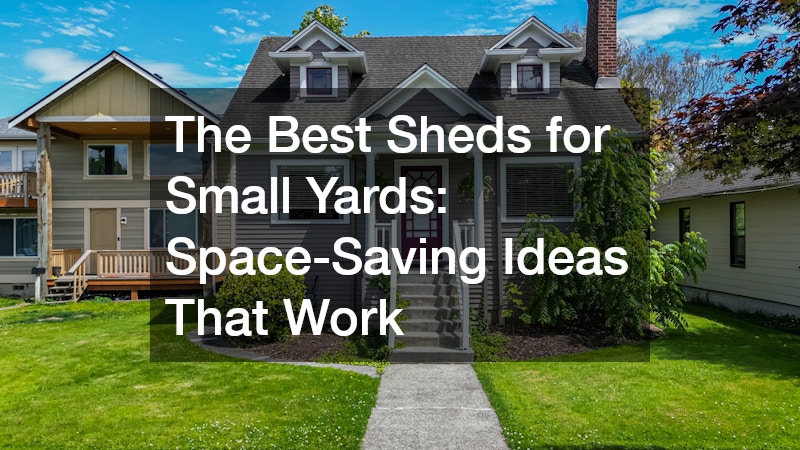Maximizing small yard space is essential for homeowners seeking both functionality and aesthetic appeal. Selecting the right shed involves considering various space constraints, ensuring it fits your needs without overwhelming the yard. This guide explores diverse shed designs and materials, aiming to assist you in making the best choice for your compact outdoor space.
The Best Space-Saving Shed Designs for Small Yards
Vertical Sheds: Utilizing Height
Vertical sheds are an ingenious solution for small yards, as they use upward space instead of occupying precious ground area. By leveraging height, these sheds efficiently store tools, garden supplies, and other items while maintaining a minimal footprint.
This design is particularly beneficial for homeowners with limited yard space, as it leaves more room for outdoor activities and greenery.
Manufacturers of vertical sheds offer a variety of sizes and styles, ensuring compatibility with different aesthetic preferences and storage needs. Many vertical sheds are equipped with adjustable shelving systems, allowing for customization and efficient organization. With their sleek designs, vertical sheds can seamlessly blend into the landscape, contributing to the yard’s overall appeal.
Corner Sheds: Optimizing Yard Corners
Corner sheds are another excellent space-saving option, designed to fit snugly into the often-unused corners of a yard. By optimizing these areas, corner sheds provide ample storage without intruding into the main space. This design is ideal for homeowners who want to maximize utility while keeping their yard open and inviting.
Available in various styles and sizes, corner sheds can be tailored to complement the aesthetic of your home and yard. Their unique angular structure allows for creative adaptation within small spaces, enhancing both storage capability and visual appeal. Corner sheds can be customized with features like double doors and windows, increasing accessibility and usability.
Choosing the Right Material and Style for Your Shed
Comparing Shed Materials: Wood, Metal, and Plastic
Choosing the right material for your shed is crucial, influencing both its longevity and maintenance requirements. Wood sheds offer a classic, natural look but require regular upkeep to prevent rot and damage from pests. Metal sheds, on the other hand, provide robust durability and resistance to the elements, making them a low-maintenance option.
Plastic sheds are gaining popularity due to their lightweight construction and easy assembly, appealing to those seeking a hassle-free solution. They resist rust and decay and often feature UV-resistant properties to withstand sun exposure. However, their aesthetic may not suit all preferences, as some homeowners prefer the timeless appeal of wood or the industrial look of metal.
Choosing a Style: Modern, Rustic, and Beyond
The style of your shed should harmonize with your home’s architecture, creating a cohesive look that enhances the overall aesthetic. Modern sheds boast sleek lines and minimalistic features, appealing to those who favor contemporary design. Rustic sheds, in contrast, often utilize natural materials and warm colors, offering a charming, homey feel that complements traditional architecture.
Beyond modern and rustic, there are many styles to choose from, including cottage, barn, and industrial designs. Each style brings its own set of characteristics and charm, allowing homeowners to express their personal taste and creativity. When selecting a style, consider not only current trends but also the timelessness of the design to ensure longevity and satisfaction.
Tips for Maintaining Your Shed in a Small Yard
Regular Maintenance Tips for Longevity
Regular maintenance is key to ensuring the longevity and functionality of your shed in a small yard. Begin by inspecting the shed’s exterior for signs of wear, addressing issues like chipped paint or loose panels promptly. Routine tasks such as cleaning gutters, lubricating hinges, and tightening bolts can prevent minor problems from escalating into costly repairs.
Implementing a seasonal maintenance schedule helps keep track of necessary tasks, with emphasis on preparing the shed for harsh weather conditions. For wooden sheds, applying protective sealants can prevent moisture damage, while metal sheds benefit from rust-proof coatings. Proper ventilation is crucial for preventing mold growth, so ventilators or windows should be kept clear and functional.
Landscaping and Surrounding Care
The environment surrounding your shed plays a significant role in its maintenance and visual appeal. Cleanliness is important; keep the area around the shed free from debris and vegetation that can harbor pests or trap moisture against the structure. Landscaping improvements, like adding gravel or stone pathways, can enhance drainage and reduce mud near the shed’s entrance.
Consider the impact of plants and trees on your shed, as roots and overhanging branches can damage the structure if left unchecked. Strategically placing plants around the shed can also improve aesthetics, providing a natural camouflage that blends the shed with its surroundings. Selecting low-maintenance plants can reduce the time and effort needed for garden upkeep.
Maximizing small yard space with the right shed involves thoughtful design choices and careful material selection. Vertical and corner sheds provide innovative solutions for space-saving, while styles and materials can be tailored to suit individual preferences and environmental needs. By following maintenance tips and enhancing the surrounding landscape, you can ensure your shed remains a functional and aesthetically pleasing element of your yard for years to come.


